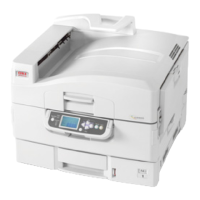13 - English
CAS#: Confidential.
OSHA PEL: Not listed.
ACGIH TLV: Not listed.
LD50: Not Available.
LC50: Not Available.
Pigment (3-10%)
CAS#: Confidential.
OSHA PEL: Not listed.
ACGIH TLV: Not listed.
LD50: Not Available.
LC50: Not Available.
Silica (1-3%)
CAS#: Confidential.
OSHA PEL: Not listed.
ACGIH TLV: 10 mg/m3.
LD
50
: Not Available.
LC
50
: Not Available.
Physical Data _________________________
Physical State:
Solid.
Melting/Freezing Point:
Not available.
Boiling Point:
Not available.
pH:
Not available.
Vapor Pressure:
Not available.
Vapor Density (Air=1):
Not available.
Evaporation Rate (Butyl Acetate=1):
Not available.
Specific Gravity (H
2
O=1):
About 1.2 at 20°C (68°F).
Solubility in Water:
Negligible.
Solubility in Solvents:
Partially soluble in toluene and
tetrahydrofuran.
Coefficient of water/oil Distribution:
Not available.
Appearance and Odor:
Yellow powder, slight plastic odor.
Odor Threshold:
Not available.
Fire and Explosion Hazard Data ___________
Minimal fire hazard. Large quantities may cause risk of dust
explosion.
Flash Point (Method Used):
Not applicable.
Flammable Limits
Lower Explosive Limit:
Not applicable.
Upper Explosive Limit:
Not applicable.
Auto-Ignition Temperature
: Not applicable.
Explosion Data
Sensitivity to Mechanical Impact:
Not available.
Sensitivity to Static Discharge:
Not available.
Extinguishing Media:
Water, foam or dry chemical.
Special Fire Fighting Procedures:
Fight fire from upwind
position. Avoid inhalation of smoke or gases. Wear
self-contained breathing apparatus. Cool the container with
water spray.
Hazardous Combustion Products:
Carbon monoxide.
Also produces carbon dioxide.
Toxicological Properties _________________
Routes of Entry:
Inhalation, Ingestion, Eyes, Skin.
Effects of Acute Exposure:
Not applicable.
Effects of Chronic Exposure:
Not applicable.
In a study in rats of chronic inhalation exposure to a typical
toner, a mild to moderate degree of lung fibrosis was
observed in 92% of the rats in the high concentration
(16 mg/m
3
) exposure group. A minimal to mild degree of
lung fibrosis was observed in 22% of the rats in the middle
(4 mg/m
3
) exposure group. No pulmonary change was
reported in the lowest (1 mg/m
3
) exposure group, the most
relevant level to potential human exposures.
Exposure Limits
(ACGIH TLV):
Inhalable Particulate: 10 mg/m
3
Respirable Particulate: 3 mg/m
3
Irritancy:
Not available.
Sensitivity:
Not available.
Carcinogenicity
IARC: No components are listed.
NTP: No components are listed.
OSHA: No components are listed.
Reproductive Toxicity:
Not available.
Teratogenicity:
Not available.
Mutagenicity:
Not available.
Name of Toxicoligically Synergistic Products:
Not
available.
Reactivity Data ________________________
Stability:
Stable in general.
Materials to Avoid:
None.
Polymerization:
Will not occur.
Hazardous Decomposition or Byproducts:
Combustion
products include carbon monoxide and carbon dioxide.
Incompatibility:
Avoid exposure to strong oxidizers.
Preventive Measures ___________________
Personal Protective Equipment
Respiratory Protection:
Not normally required. For large
spills, use dust respirator mask during cleanup.
Protective Gloves and/or Eye Protection:
Not normally
required. For large spills, use leather gloves and safety
goggles during cleanup.
Engineering Controls
Ventilation:
Outside of normal ventilation, not normally
required.
Other Protective Equipment and/or Hygienic
Practices:
None.
Spill Cleanup
Small Spills
1. Remove sources of ignition.
2. Carefully clean up the spill with a wet cloth, avoiding
inhalation of fine dust.
Large Spills
1. Remove sources of ignition and keep unnecessary and
unprotected personnel away from area.
2. Wear protective gear: dust respirator mask, leather
gloves, safety goggles.
3. Vacuum or sweep the material into a bag or other
sealed container, then wipe up remainder with a wet
cloth.
Waste Disposal
• Prevent release of material into natural waters and
sewers.
• Follow appropriate federal, state and local regulations.
• Small amounts can be incinerated.
Careful! Combustion can create harmful gases such as
carbon monoxide.
• Large amounts must be passed to a licensed waste
contractor.

